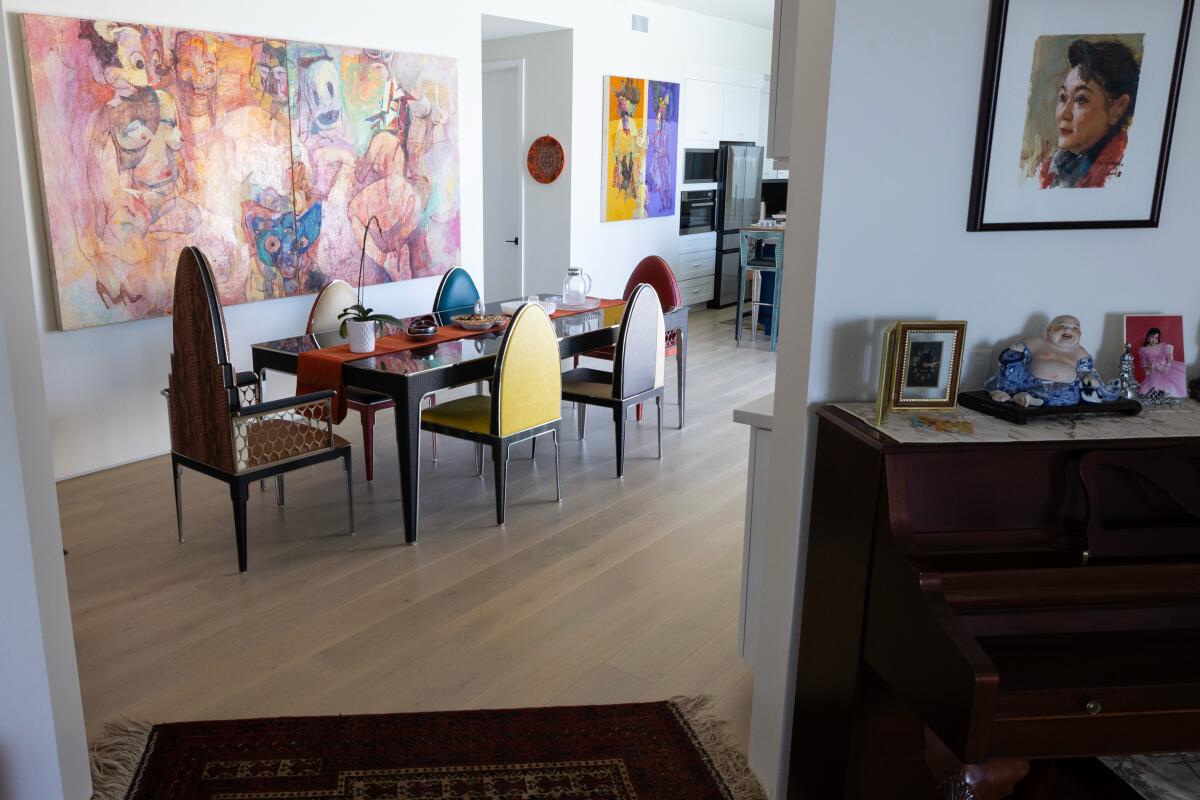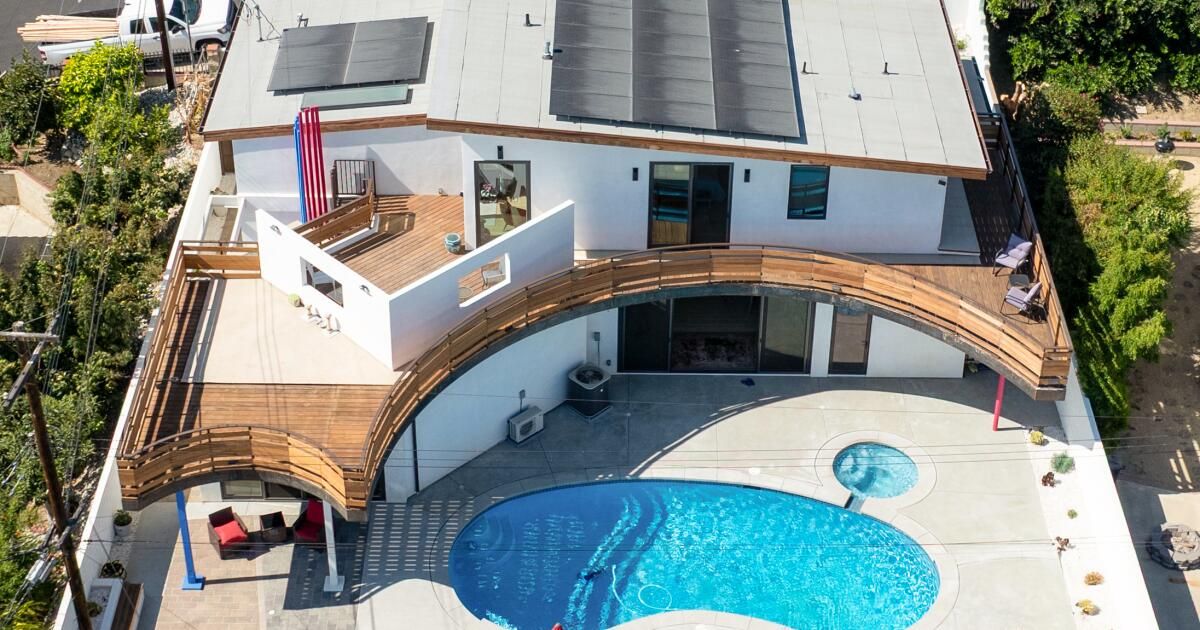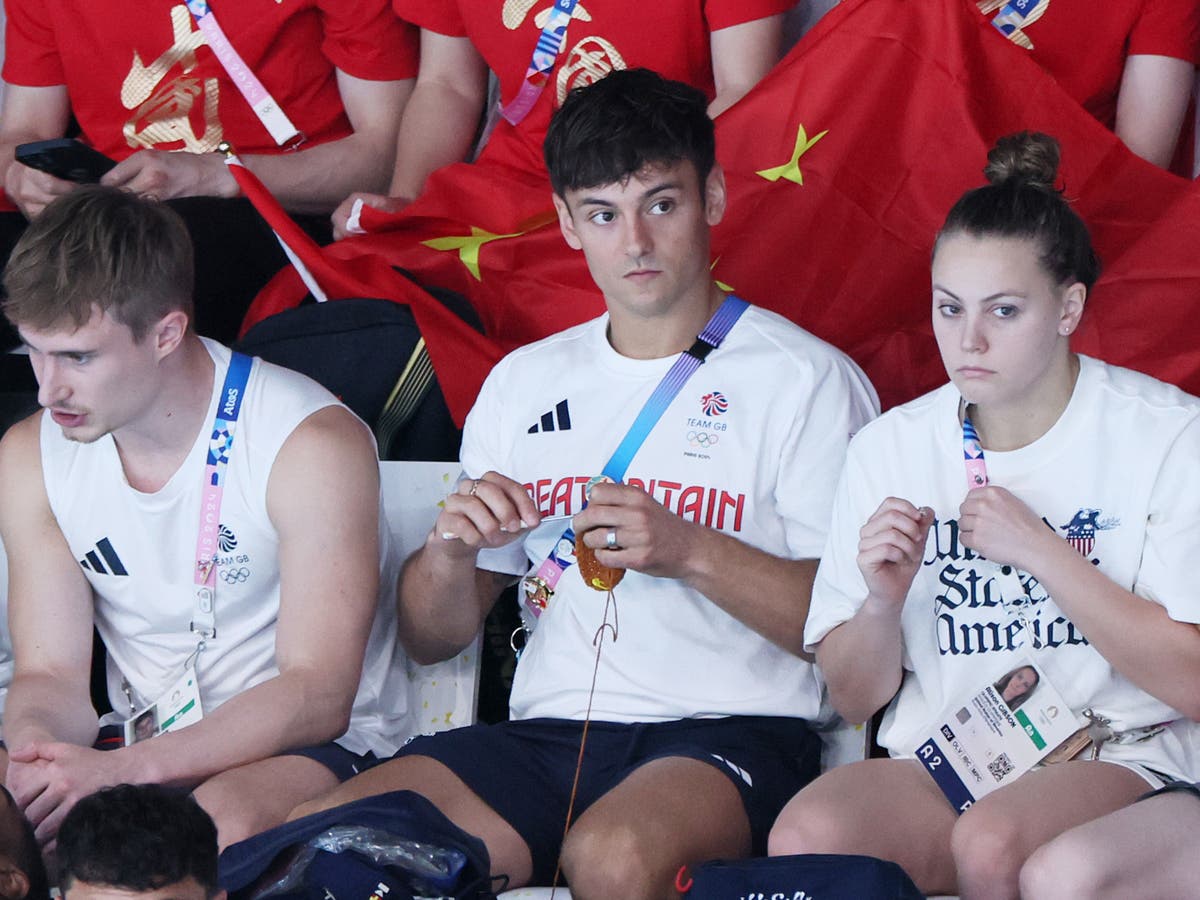The first thing you notice about the house of Monterey Park by artist Yi Kai and his wife, Jian Zheng, is the pool. Like the paintings of the pool of David Hockney, which celebrate the landscapes full of Sol de Los Angeles, the bright waves of the pool water reverberate throughout the first floor, as well as the Los Angeles horizon in the distance.
“This house has always been treated not simply as a construction project, but as a work of continuous evolution,” says Kai. “Over time, we have been refining, altering it and reinventing it, a process that reflects the values of experimentation and transformation.”
The blue pool, a characteristic par excellence Californian, is not only a recreational space, but a central element of the new house, which was built from scratch after the 1956 house was demolished. According to the architect of Peter Yi, who designed the newly finished house for his aunt and uncle in collaboration with the architect Laura Marie Peterson, the original kidney -shaped pool of the house was a lovely surprise when entering the house.
The movement of the house while curving around the pool “leaves the rigid construction of the house,” says Yi, and is a deliberate design choice that symbolizes the combination of Chinese and American cultural elements.
“We wanted to make outdoor spaces useful and charming,” says artist Yi Kai, 70, who built a new home with his wife, Jian Zheng, 65. “The balcony provides views that you would not normally get.”

The 1956 house by Kai and Zheng in Monterey Park before it was demolished.
(From Peter Yi)
The magical quality of the pool extends far beyond the first floor. Above, a teak cover 80 feet long curve, allowed within 50% of the rear setback, revolves around the pool, making outdoor spaces feel much larger than they are. The partial height walls frame the city, creating a series of outdoor places that feel like rooms.
“For me, the house was really about opening views and specific moments to create a series of interior outdoor rooms,” says Peterson.
An 80 -feet walkway creates memorable moments outdoors, says Yi, “taking something mundane and making it special” by framing the light as it changes throughout the day.
“We are framing that opinion,” says Yi, comparing it with the “skyspaces” outdoors of James Turrell (including the outdoor pavilion “dividing the light” in the Pomona College) where Turrell frames a part of the sky with a built environment.

Kai and Zheng inside their new home.
Kai, who is a American Chinese, says that his works of art combine aspects of his inheritance, but are “focused on a single subject: understand and reflect on the human condition.”
Look closely and see Kai's artistic touches throughout the house. For example, an outdoor spiral ladder, a connection between the roof and the garage study on the ground floor, is a surprising feature. It is projected in nine 18 -foot wooden strips of the original house of the couple and painted in red and blue with a white seven -level base, a design that echoes the colors of the American flag.

The outdoor spiral staircase is composed of reused wood from the couple's demolished house.
Another unique feature in the home is a long slot, reminiscent of a trap door, which allows Kai to move his paintings from his study on the first floor to a space similar to the attic on the second floor where he stores them.

Kai and Zheng pass one of their oil paintings through the roof of their study to their office on the second floor of their home. Kai says he had the idea after visiting Cézanne's study in France.

Kai's paintings are stored in the house's office on the second floor.
Yi says that his uncle's deep interest in Chinese and American culture is vividly reflected in the design of the house. The slope of the ceiling, for example, reflects the roofs of butterflies from the mid -century scattered throughout the predominantly Chinese neighborhood, while the arc of the terrace refers to historical houses and gardens in China.

The house was designed to have a low profile in the front.

Kai, 70, was born and grew up in China and was written in the popular liberation army as a railway soldier at age 15. After the protests of Tiananmen Square in 1989, Kai fled from China and moved to the United States, where he lived for 13 years in Minneapolis and briefly in Boston, before meeting with Jiang and settling in Los Angeles.
In 1998, the couple bought a three bedroom house near Jian's office in Monterey Park, which is often known as “Little Taipei”, due to the large number of China immigrants residing there. “It was easy for us to integrate into the community,” says Kai.
Eight years later, when Kai got a teaching work at the University of Graduates of Claremont, they rent the house and moved to Rancho Cucamonga to be closer to Kai's work.
When the couple began thinking about retiring in 2014, they turned to their nephew for help to reinvent their home so they could return to Monterey Park.


Paul's colorful furniture, based in China, in collaboration with the artist Lu Biaobiao, in the living room and the dining room, play with the colors, symbols and textures of Kai's paintings.

Kai in his home art studio.
After years of working as an artist, Kai had modest dreams for retirement: he wanted a place where he and his wife feel comfortable. “Peter wanted to design a special house related to art,” says Kai.
Due to logistics and financial reasons, they decided to demolish the original house, which the tenants had rented for 16 years, but retain the pool. Today they are glad they have done it. “The pool inspired everything that is special about the house,” says Yi on the project, which included requests for maximum life space, a first floor room with a suite bath for the purpose of aging in the place and an art study for Kai.
“I told him to use his imagination,” says Kai. “I am a first generation from China. He is a second generation immigrant. I thought:” Let's take his American ideas and my Chinese ideas and combine them. “

Structural Engineer Halle Doenitz, the left, Peter Yi's architect, the owners Yi Kai and Jian Zheng, and the general contractor Larry Ton inside the house.

Peter Yi architect in the shadow of the balcony.
As an immigrant, Kai says that he is proud of the multicultural group that worked in the project at home for 30 months. “Our main designer, Peter Yi, arrived in the United States at age 5 [and] He is a second -generation American Chinese, “says Kai.” Gabriel Armendariz, another designer, comes from Mexico and brings a Latin cultural formation. Halle Doenitz, our structural engineer, is an American Caucasian woman. Mz Construction has two partners, one from Hong Kong and one from Continental China, and Larry Ton, our contractor, has artistic history. “
His efforts have been worth it. The interiors of the 2,200 square feet house are expansive and aerated, with easy access to the outdoors. In particular, outdoor kitchen, located on the other side of the interior kitchen, is a characteristic that the couple uses daily for their sauteed recipes.

The palm trees appear in the second floor bath window.

The water waves of the pool reverberate through the rooms on the first floor.
Asymmetric windows on both floors of the house provide indirect lighting for Kai's works of art, responding to the geometry of the house and imitating their joy.
Like the views from the terrace, the lines of vision change constantly (the palm trees appear in a window, the tree of one neighbor in another, depending on where they look. “The windows respond to the different views and an interesting topography of the angels,” says Yi. “There is beauty on the side wall and the neighbor's trees. The views extend the house out.”
Similarly, Pablo's colorful furniture, based in China, in collaboration with the artist Lu Biaobiao, in the living room and the dining room, play with the colors, symbols and textures of Kai's paintings.
Up, where a tea room connects to the main bedroom and bathroom, the entire living room, which includes the office where Kai stores its paintings, connects to the enveloping terrace. In addition to 450 square feet of balcony space on the second floor, the terrace adds 650 additional square feet of shaded outdoor space on the ground floor.

The partial height walls give it a corner of the outdoor cover the sensation of a room. “It's beautiful to see how light changes throughout the day,” says Kai.
Although he lives in Cincinnati, the couple's nephew says he was gratifying for him to visit his family in his new home, which finally cost $ 1.5 million to build. “It has been incredible to see how they use the house,” he says.
Ultimately, Kai hopes to open the house to the public for halls, exhibitions and intercultural exchanges.
“The United States is my home,” he says, “a place where I have realized many dreams and achieved personal and professional success. It is also the place where I want to give back, contributing to everything I can: my art, my knowledge and my energy, to help enrich US culture in exchange.”
Zheng adds: “Everyone can appreciate art, everyone can love it. But not everyone really brings art to their daily lives or integrates it with the way they live. Our goal is to inspire a change in mentality, show that art is something that everyone can enjoy and that it can be a significant part of everyday life.”












